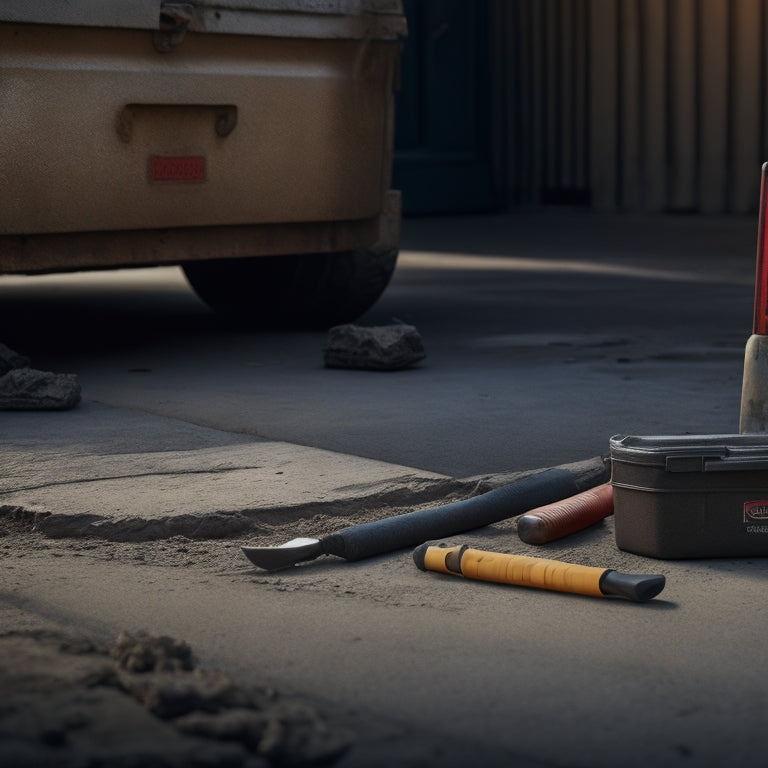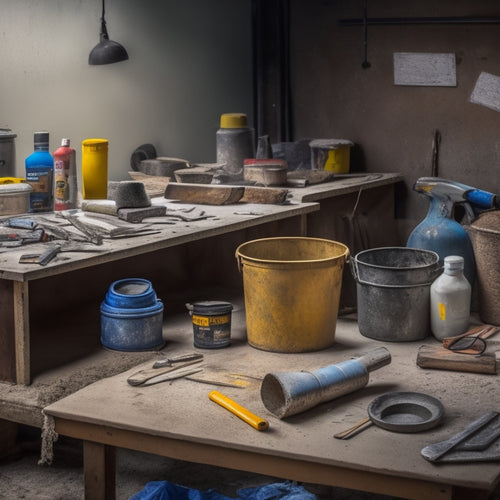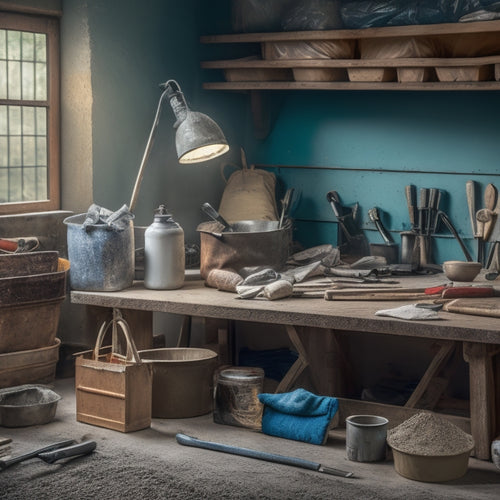
Why Invest in Quality Concrete Repair Tools
Share
You invest in quality concrete repair tools because using low-quality or poorly maintained equipment can lead to a staggering 30% of total project costs being spent on rework and repair, directly affecting your bottom line. By choosing reliable tools, you guarantee job site safety, reduce the risk of personal injury, and extend tool lifespan. You also avoid costly project delays, protect your equipment investments, and maintain consistent quality work while minimizing environmental impact risks. Additionally, quality tools improve overall efficiency gains, allowing you to optimize resource allocation and increase revenue. Now, explore the nuances of each benefit to transform your concrete repair operations.
Key Takeaways
• Quality concrete repair tools ensure job site safety and compliance, reducing the risk of accidents and legal liabilities.
• Investing in quality tools improves operator efficiency, reducing labor costs and project time, and increasing revenue.
• Well-maintained tools reduce the risk of personal injury, enhance familiarity with the repair process, and boost productivity and morale.
• Quality tools protect equipment investments, reduce costly project delays, and ensure consistent quality work, leading to a higher return on investment.
• Efficient tools minimize environmental impact risks, such as soil contamination, and optimize resource allocation, reducing waste and budget mismanagement.
Ensuring Job Site Safety Standards
Implement a thorough job site safety plan to prevent accidents and guarantee compliance with industry regulations and standards.
You'll need to identify potential hazards and develop strategies to mitigate them. Start by evaluating job site ergonomics, making sure that your workspace is organized and efficient. This includes arranging tools and equipment to minimize strain and reduce the risk of accidents.
Next, establish tool maintenance practices to confirm that your equipment is in good working order. Regularly inspect and maintain your tools to prevent malfunctions and extend their lifespan. This won't only reduce the risk of accidents but also improve productivity and reduce downtime.
Additionally, develop procedures for handling hazardous materials and substances, and provide training to your team on proper handling and disposal techniques.
Reducing Risk of Personal Injury
Reducing Risk of Personal Injury
To minimize the risk of personal injury, you must prioritize proper body positioning and lifting techniques when handling heavy concrete repair tools and materials. This is vital to avoid strains, sprains, and other musculoskeletal disorders that can result from incorrect lifting and handling practices.
Quality concrete repair tools with ergonomic design features can greatly reduce the risk of injury. These tools are designed to fit comfortably in your hand, reducing fatigue and strain.
Additionally, user training is essential to guarantee you're using the tools correctly and efficiently. Proper training will teach you how to lift and handle tools safely, reducing the risk of accidents and injuries.
By investing in quality tools and training, you can minimize the risk of personal injury and guarantee a safe working environment. Moreover, a safe working environment boosts productivity and morale, leading to better job outcomes and increased job satisfaction.
Protecting Expensive Equipment Investments
You need to take proactive measures to protect your expensive concrete repair equipment investments from damage, misuse, and premature wear to guarantee they remain in peak working condition and provide a solid return on investment.
Conducting a thorough cost analysis will help you understand the importance of tool durability and the potential losses associated with equipment failure. By investing in quality concrete repair tools, you can greatly reduce the risk of damage and extend their lifespan.
Regular maintenance, proper storage, and operator training are essential in preventing misuse and premature wear. Additionally, using protective accessories such as tool cases and covers can shield your equipment from environmental factors and physical damage.
Preventing Costly Project Delays
Delays in concrete repair projects can quickly balloon into significant cost overruns, making it vital to identify and mitigate potential bottlenecks proactively. You can't afford to have your project stalled due to inefficient workflow or inadequate tools. That's why investing in quality concrete repair tools is essential for preventing costly project delays.
By streamlining your workflow optimization, you can identify potential roadblocks and address them before they cause significant disruptions. This starts with effective project scheduling, where you allocate resources and prioritize tasks to guarantee a smooth workflow.
With the right tools, you can complete tasks efficiently, reducing the likelihood of delays. Quality concrete repair tools also enable you to work smarter, not harder. They're designed to simplify complex tasks, reducing the risk of human error and minimizing downtime.
Meeting Industry Regulations Requirements
When you're working on a concrete repair project, you're not just focused on getting the job done - you're also responsible for ensuring that your work meets industry regulations.
You need to comply with safety standards that protect you and your team from hazards, and adhere to building codes that guarantee the structural integrity of the repaired concrete.
Compliance With Safety Standards
Concrete repair professionals must assure their tools and equipment meet industry regulations and safety standards to prevent accidents and minimize liability. You can't afford to compromise on safety, as it not only protects you and your team but also guarantees the quality of your work.
When selecting concrete repair tools, look for safety certifications from reputable organizations, such as OSHA or ANSI. These certifications assure that the tools meet rigorous safety standards, reducing the risk of accidents and injuries.
Additionally, consider tool ergonomics, which plays a critical role in preventing fatigue and discomfort. Well-designed tools with ergonomic grips and handles can reduce the risk of musculoskeletal disorders and improve your overall productivity.
Adherence to Building Codes
You must also ascertain that your concrete repair tools and techniques comply with local building codes and industry regulations, as non-compliance can lead to costly rework, project delays, and even legal liabilities. Building code compliance is essential to guarantee that your repairs meet the required standards, and you avoid any potential risks or penalties. Staying up-to-date with regulatory updates is critical to maintaining compliance, as codes and regulations are subject to change.
Here's a breakdown of the importance of building code compliance in concrete repair:
| Compliance Aspect | Benefits |
| Meeting Structural Integrity | Guarantees safety of occupants and users |
| Adhering to Material Standards | Assures durability and quality of repairs |
| Following Design and Construction Guidelines | Reduces risk of rework and project delays |
| Complying with Environmental Regulations | Minimizes environmental impact and liabilities |
| Staying Current with Regulatory Updates | Avoids penalties and ascertains continued compliance |
Boosting Operator Confidence Levels
Six key factors contribute to boosting operator confidence levels, starting with proper training on the equipment and materials used in concrete repair projects. This foundation of knowledge helps you understand the capabilities and limitations of your tools, allowing you to tackle complex repairs with ease. As you work with quality concrete repair tools, you'll notice a significant improvement in your operator morale. With the right tools, you'll feel more in control, and your productivity will increase.
Here are four essential factors that further enhance your confidence:
-
Familiarity with the repair process: Understanding the concrete repair process from start to finish helps you anticipate and overcome challenges.
-
Clear instructions and guidelines: Having access to detailed instructions and guidelines guarantees you're following best practices and meeting project requirements.
-
Regular equipment maintenance: Properly maintaining your tools prevents equipment failure, reducing downtime and increasing your confidence in the tools.
- Real-time feedback and support: Having access to real-time feedback and support from experienced professionals helps you troubleshoot issues and stay on track.
Extending Tool Lifespan Expectancy
Proper tool maintenance and care, a natural extension of the operator confidence built through training and process understanding, play a considerable role in extending the lifespan of your quality concrete repair tools.
By implementing effective tool maintenance strategies, you can greatly reduce wear and tear, preventing premature tool failure. Regular cleaning, lubrication, and inspection are essential in identifying potential issues before they become major problems. You should also develop a routine for storing and transporting your tools to prevent damage.
Longevity assessment techniques, such as tracking tool usage and performance, will help you identify areas for improvement and enhance your maintenance schedule. By doing so, you can extend the lifespan of your tools, reducing replacement costs and downtime.
Additionally, well-maintained tools will continue to perform at peak levels, guaranteeing consistent results and reducing the risk of accidents. By prioritizing tool maintenance, you'll get the most out of your investment and guarantee your concrete repair operations run smoothly and efficiently.
Maintaining Consistent Quality Work
Three key elements - operator expertise, quality concrete repair tools, and a well-planned workflow - must converge to maintain consistent quality work in concrete repair operations.
You understand that consistency is vital in concrete repair, and it's achieved by implementing consistency practices that guarantee quality assurance.
To achieve this, you should:
-
Establish standard operating procedures (SOPs) that outline the steps to follow for each task, guaranteeing that every operator performs the task similarly.
-
Conduct regular operator training to guarantee that everyone is knowledgeable about the SOPs, tools, and materials used.
-
Implement a quality control process that includes regular inspections and testing to identify and correct any defects or deviations from the SOPs.
- Use data and analytics to track performance metrics, identify trends, and make data-driven decisions to improve your workflow and quality of work.
Minimizing Environmental Impact Risks
When you're working with concrete repair tools, you need to be mindful of the environmental risks involved.
You'll want to take steps to reduce chemical leaks and prevent soil contamination, as these can have long-term, far-reaching consequences.
Reduce Chemical Leaks
You can minimize environmental impact risks by identifying and addressing potential chemical leak sources in your concrete repair operations.
Chemical leaks can contaminate soil, water, and air, causing long-term environmental damage. To reduce chemical leaks, you should prioritize chemical containment and leak detection in your operations.
Here are some key strategies to implement:
-
Regularly inspect equipment and storage containers for signs of wear, corrosion, or damage that could lead to chemical leaks.
-
Implement a leak detection system that can quickly identify potential leaks and alert your team to take action.
-
Use secondary containment systems, such as spill berms or drip pans, to catch any accidental chemical releases.
- Train your team on proper chemical handling and storage procedures to prevent human error from causing chemical leaks.
Prevent Soil Contamination
Properly disposing of concrete repair materials and waste helps prevent soil contamination, a critical step in minimizing environmental impact risks. When you invest in quality concrete repair tools, you're not only ensuring a durable and long-lasting repair, but also protecting the surrounding soil health. Soil contamination can have devastating effects on the ecosystem, including pollution of groundwater sources and harm to local wildlife.
To prevent soil contamination, it is crucial to follow proper disposal procedures for concrete repair materials and waste. Here are some key considerations:
| Material | Disposal Method |
|---|---|
| Excess concrete | Dispose of in designated concrete recycling facilities |
| Chemicals and solvents | Dispose of through hazardous waste collection programs |
| Packaging materials | Recycle or dispose of through regular waste collection |
| Waste water | Dispose of through sanitary sewer systems or designated wastewater facilities |
| Used tools and equipment | Clean and store for future use or dispose of through designated facilities |
Improving Overall Efficiency Gains
Efficient concrete repair tools streamline workflows, enabling contractors to complete projects faster and reduce labor costs. By investing in quality tools, you'll experience significant productivity gains, allowing you to take on more projects and increase revenue.
Here are four ways quality concrete repair tools improve overall efficiency:
-
Reduced downtime: Well-maintained tools minimize breakdowns, ensuring you can work continuously without interruptions.
-
Improved workflow optimization: Quality tools are designed for specific tasks, streamlining your workflow and reducing the time spent on each project.
-
Enhanced productivity: With the right tools, you can complete tasks faster, freeing up time to focus on other aspects of your business.
- Better resource allocation: By completing projects efficiently, you can allocate resources more effectively, reducing waste and optimizing your budget.
Frequently Asked Questions
How Do I Choose the Right Concrete Repair Tool for My Project?
When choosing the right concrete repair tool for your project, you'll want to develop effective tool selection strategies.
First, identify your project's specific requirements, considering factors like repair type, surface area, and environmental conditions.
Then, research and shortlist tools that meet these needs.
Evaluate their performance, durability, and ease of use.
Can I Use Concrete Repair Tools for Other Construction Tasks?
You're wondering if you can use concrete repair tools for other construction tasks. The answer is yes; many tools are designed for versatile applications.
A high-quality trowel, for instance, can be used for applying adhesives, smoothing surfaces, or even mixing materials.
Tool durability also plays a role, as a sturdy tool can withstand the demands of various tasks.
What Is the Average Cost of Quality Concrete Repair Tools?
Imagine you're working on a high-rise building repair project, and you need to fix a 10,000-square-foot concrete slab.
You'll likely need a range of quality concrete repair tools, including a concrete mixer, trowels, and a scarifier. The average cost of these tools can range from $5,000 to $15,000, depending on the brand, quality, and durability.
When comparing costs, consider that high-quality tools may be more expensive upfront, but they'll last longer and perform better, reducing replacement costs and downtime in the long run.
Are Concrete Repair Tools Compatible With All Concrete Types?
When you're working with concrete, you'll encounter various concrete types, each with unique properties.
You're right to wonder if concrete repair tools are compatible with all of them. The answer is, it depends.
Some tools are designed for specific concrete types, while others are more versatile.
You'll need to take into account factors like surface preparation, bonding agents, and curing methods to guarantee tool compatibility.
Research the tool's specifications and manufacturer recommendations to verify a successful repair.
Do Quality Concrete Repair Tools Require Special Maintenance?
You'll find that quality concrete repair tools don't require daily or weekly special care, but they do need regular attention to guarantee tool longevity.
You'll need to clean them after each use, store them properly, and perform occasional deep cleaning and lubrication.
Conclusion
As you weigh the costs and benefits of investing in quality concrete repair tools, remember that the stakes are high.
A single misstep can be catastrophic, like a house of cards crumbling beneath your feet.
By choosing the right tools, you're not just protecting your bottom line - you're safeguarding your reputation, your team's well-being, and the environment.
Make the smart investment, and reap the rewards of a job well done.
Related Posts
-

3 Best Tools to Buy for Concrete Repair Online
When buying tools for concrete repair online, you'll want to research multiple retailer options to find the best prod...
-

Essential Tools for Epoxy Concrete Floor Repair
You'll need a thorough arsenal of specialized tools to guarantee a successful epoxy concrete floor repair. Floor prep...
-

10 Must-Have Tools for Small Concrete Projects
When tackling small concrete projects, you'll need a range of essential tools to achieve professional-grade results. ...


